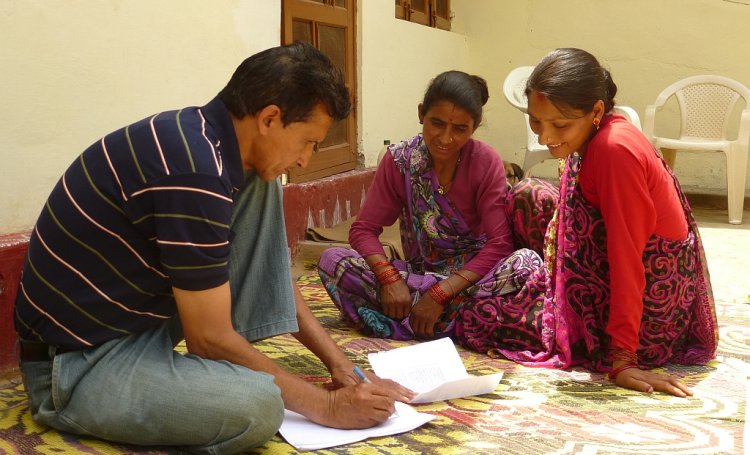
I first met Kunti and Priya at a meeting of the Springs Initiative, which is a network of organisations and individuals working across India to restore their springs. Both from Kulgad village, they had come to talk about the work they had done on their spring. The officials present at that meeting were awed when Priya tacked a map of her village to the board and explained it; they were utterly taken aback when Kunti pulled out two rock samples from her bag and said, “You might not know what phyllites and quartzites are, so I brought these to show you”.

Hydrogeology opens windows
Kunti and Priya have come a long way since they first undertook responsibility for their groundwater. In November 2014, the people of Kulgad attributed the workings of Kulgad Naula, the spring from which they took water, to the Gods’ whims. When the spring in Singoli, a neighbouring village, suddenly dried up the villagers immediately assumed that a menstruating woman must have touched it. Simultaneously, the people of Kulgad considered themselves fortunate that their spring which was formerly a trickle, started to gush forth.
They couldn’t see the connection between the two events.
Today, after participating in CHIRAG’s springs programme, they are conversant with hydrogeology. They now know that these two springs are located on the same fracture; it was probably a minor tremor and not a whimsical God that led to the changes. With their new knowledge of hydrogeology, the people of Kulgad now rely on their own efforts rather than luck to ensure that they do not run out of water.
However, according to Sarita, another member of the Kulgad springs committee, hydrogeology was not the biggest challenge they faced. In the course of conserving their spring, they discovered that science was easy. It was humans that were difficult.
Vested interests block paths
When the people of Kulgad mapped their spring, they realised that the recharge area for their village spring lay in another village — Singoli. “No problem”, they thought. After all, they knew the Tiwaris, the family who was responsible for much of the village’s land. Located just above Kulgad, Singoli is an example of a phenomenon that is increasingly found in Uttarakhand — that of the deserted village. Only one family remains of the original 30 households; the others have all moved out, leaving their homes to fall to ruins. The lone Tiwaris ensure that no one encroaches on the land of their erstwhile neighbours and have, in a sense, become the caretakers of that village.
Vinod Tiwari, the son of the household, did not understand why he should cooperate to bring water to Kulgad’s spring. The people of Kulgad were taken aback when he prevented them from working on Singoli soil, claiming that the owners had objected. Kunti and Sarita thought otherwise. “He wanted some benefits for himself and his family and we didn’t know what to do”.

Learning from past experience
This issue, of the spring and its recharge area being in two different villages, is something that CHIRAG has faced before in the case of Bhadyun and Bheduli. There, it took the team — especially Budaniji — two years of trekking up and down the Bhadyun mountain before the two villages came to an agreement. This time, Budaniji wanted to see if peer-to-peer learning was possible. So he took the Kulgad spring committee on a field visit to Bhadyun, and then waited and watched.
Bhushan Singh of the Bhadyun springs committee counselled them well. “Go and speak to them”, he said. “Explain the project properly, explain its benefits. We cannot give them money, but can offer some other benefits”. And this is precisely what Sarita Devi and Gopal Singh of Kulgad did in their next meeting with Singoli.
The solution
They decided that they would make similar efforts to revive Singoli’s spring. Sarita later told me, “That spring has been dry for 20 years and Singoli has piped water supply. But we agreed because that was the only way we could also work on our own spring”. The recharge area for Singoli was on the other side of the mountain. Working in the Tiwari’s land simply would not yield results. Instead, they decided to construct a sub-surface checkdam to hold back whatever water reached the spring.
Vinod explained that he was earlier not certain what this project was all about. He was afraid that if the land he was responsible for was damaged or encroached upon, he would be held responsible. Now he not only understood how it worked, but was also committed to the process. Vinod has now started constructing percolation pits on his own land and planting trees there. “It can only benefit the land”, he says. It turns out though, that Vinod’s acquiscence was triggered by a fear of loneliness. “Singoli became empty after the naula dried up. Now we are entirely dependent on Kulgad for friends and functions. If they leave because the water is less, what will we do”?
Vinod’s fear of being the last man in the area definitely acted as catalyst in resolving this issue but this would not have happened without Bhushan’s advice to the Kulgad springs committee. Today, Priya, Kunti and Sarita are confident of managing their own spring.
“Will you be able to help another village if it comes to you for advice”?, I asked. “Yes!” came back a chorus of voices.
First published on India Water Portal